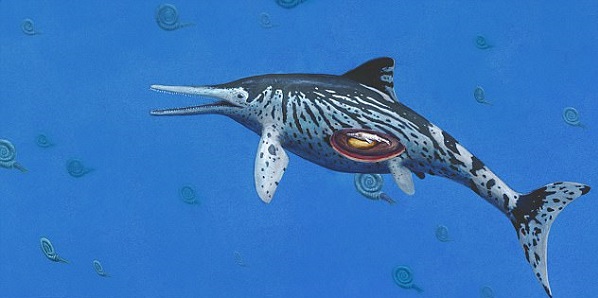The foetus of an Ichthyosaurus has been discovered still inside the womb 200 million years after its mother died during pregnancy.
The 3.5 metre (11ft) pregnant ichthyosaur lived at the time of the earliest dinosaurs during the early Jurassic period.
Scientists said the incomplete embryo was less than seven centimetres long and consisted of preserved vertebrae, a forefin, ribs and a few other bones according to Daily mail.
There was evidence the foetus was still developing in the womb when it died.
The find adds to evidence that ichthyosaurs, some of which grew to more than 20 metres (65 ft), gave birth to live young unlike egg-laying dinosaurs.
Dean Lomax, , who co-led the team, said: ‘This specimen provides new insights into the size range of the species, but also records only the third example of an ichthyosaurus known with an embryo – that’s special.’
The creature, named ichthyosaurus some rsetensis, was discovered during the 1990s.
The new study also showed that a tail from another ichthyosaur had been added to the skeleton to make it appear more complete and visually appealing for display.
Palaeontologist Dr Sven Sachs, who also took part in the research, said: ‘It is often important to examine fossils with a very critical eye.
‘Sometimes, as in this instance, specimens aren’t exactly what they appear to be.
‘However, it was not “put together” to represent a fake, but simply for a better display specimen.
‘Specimens like this provide palaeontologists with important information about when these animals lived.
‘Many examples of ichthyosaurus are from historical collections and most do not have good geographical or geological records, but this specimen has it all.’
The specimen was the largest of the ichthyosaurus family of ichthyosaurs on record, said the scientists.
Ichthyosaurs were a highly successful group of sea-going reptiles that became extinct about 90 million years ago.
Often misidentified as swimming dinosaurs, these reptiles appeared before the first dinosaurs had evolved.
They evolved from an as-yet unidentified land reptile that moved back into the water.
The huge animals, which remained at the top of the food chain for millions of years, developed a streamlined, fish-like form built for speed.
Scientists calculate that one species had a cruising speed of 22 mph (36 kmh.
The largest species of ichthyosaur grew to over 20 metres (65 ft) in length.
N.h.Kh

